By Meredith Turnbough and Marcella Martos
Illustrated by Sabine Deviche and Dr. Biology
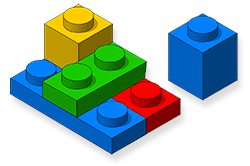
What are Proteins?
If you have ever had to get inside a locked car or home you know that shape matters. If you don’t have the right key, you cannot open the door. The shape of the key is important.
When you are building with Legos, you have to use the right shape bricks in the right combination to create your totally sweet fort, space shuttle, T-Rex, or whatever else you can imagine building. The shapes and combinations of the parts make up the final shape of the whole, completed project.
Shape Matters
In living things, shapes also matter. There are lots of different molecules in your body with different jobs to do. Some of them hold your body up and give it structure like Lego bricks. Some of them carry important things from place to place in your body. They are kind of like the post office, except really fast and really small. Some of them act like little machines that put new molecules together or break old ones apart. There are even ones that work like doors to let things in and out of a cell. Proteins are doing all this and a lot more inside your body.
To keep working correctly, each protein needs to keep its specific shape. Proteins need specific conditions, like the right temperature, amount of water, or amount of salt, to keep that shape. If they experience conditions outside of that, they may break, or denature.
Little Pieces
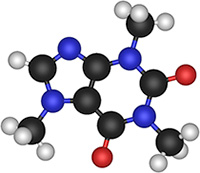
You are going to see the word "molecule” used in Venom! What does it really mean? The word itself comes from Latin. If we break it into parts, “mole” means mass (you can think of mass as being similar to weight). Adding “ule”, means small or cute.
So a molecule is something that has mass but is very small. This is just like adding “ling” to the word duck. Now we have duckling, a smaller, cuter version of a duck. People started using the word molecule when they knew things must be made up of small parts, but didn't really know what those parts were.
Kinds of Proteins
Proteins can be put into groups based on what kind of shape they have, whether or not they dissolve in water, by what they do, or in lots of other ways. Think about putting shoes into groups…would you separate them by color? How about by heel height? Laces or no laces? Leather or fabric? There would be a lot of ways to do this, but one of the easiest ways is by function. It makes sense to put all the running shoes together, all the dress shoes together, etc. We will think about proteins in the same way and put them in groups based on what they do.
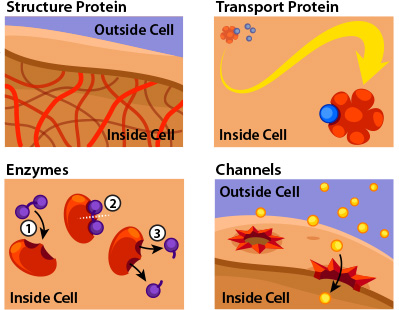
Structural Proteins
An important job that proteins do is providing structure. Collagen is a good example of a structural protein. It holds different parts of your body together like glue, and makes up about 25% of all the protein found in your body. Collagen connects and supports your muscles, bones, tendons, ligaments, blood vessels, organs, cartilage, and even holds your skin together.

Some people’s bodies accidentally make one of kind of collagen incorrectly. Without support from this collagen, their bones can’t develop properly and they end up with bones that break very easily. This disease is called osteogenesis imperfecta (osteo=bone, genesis=to make, imperfecta= not perfect), but most people call it brittle bone disease.
Transport Proteins - Like the Postal Service, Only Smaller
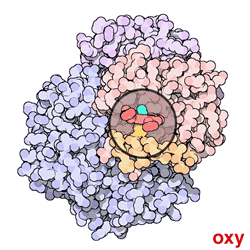
Transport proteins help move other molecules around your body. Hemoglobin is a protein found in your red blood cells that carries oxygen from your lungs to every cell in your body. That’s like the post office being able to bring new packages to ten trillion houses every second of every day all year long. How could that possibly work? We could never hire enough mail carriers and the streets would be jammed with mail trucks.
But what if we had lots of postal workers and made them really, really small? What if we made them so small that we could fit 250 million of them in a single truck that was the size of one red blood cell? Your body has a system just like that.
Your lungs are lined with many very thin tunnels called capillaries that carry blood. Every time you take a breath, oxygen molecules from the air inside your lungs enters the capillaries and gets picked up by the hemoglobin molecules inside your red blood cells. The blood then flows around your whole body to make sure all your cells have what they need. Go ahead, take a deep breath and think of all those little hemoglobin postal workers picking up oxygen and hustling off to make their deliveries.
Enzymes - Go Faster!
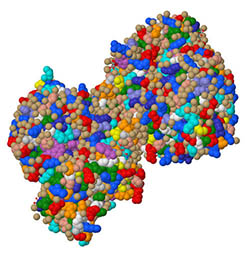
Enzymes are like little machines. Some of them build bigger molecules from smaller blocks, like putting Legos together, and some of them break bigger molecules down into smaller parts.
Whether building or breaking, most enzymes can do this 50 to 5,000 times per second. That’s really fast - Can you think of anything you can do 5,000 times per second? Without enzymes, many of the things your cells need to stay alive would take hours, days, or even longer to make. In fact, one reaction that is part of the way your body makes new hemoglobin would take 2.3 billion years without an enzyme. That’s way too long!
Your saliva glands, stomach, small intestine, and pancreas make many different kinds of enzymes to digest, or break down, the food you eat into in to molecules which your cells can use. Amylase is an enzyme made by your saliva glands to help break starch down into sugar. Try this: put a cracker (salt side up) on your tongue and wait. At first, the cracker tastes, well, like a cracker, but as your mouth waters (makes saliva) the amylase in your spit will start to turn the starch in the cracker into sugar, making it taste sweet.
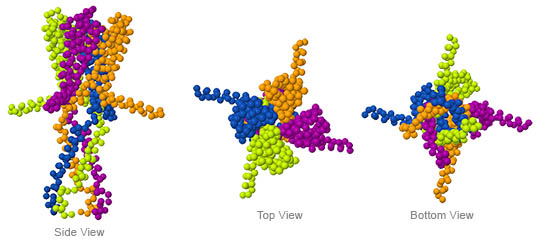
Channel Proteins - Molecular Doorways
Cells have to be able to get stuff in and out, just like a business would have to do. Raw materials have to enter, things that they make need to go out, and of course they need to be able to communicate with the outside world. There are lots of ways to get things into and out of a cell, but one way is with a channel protein.
A channel protein acts like a doorway with a security guard posted next to it. It will only let certain molecules into or out of the cell. Some channel proteins are open all the time and some can be opened and closed depending on signals sent from the cell or received from the environment.
References and credits:
Animated Hemoglobin molecule from PDB-101. Copyright 2012. David Goodsell & RCSB Protein Data Bank. May 2003 Molecule of the Month.
Additional images via Wikimedia.
Read more about: Venom!
Bibliographic details:
- Article: What Are Proteins?
- Author(s): Dr. Biology
- Publisher: Arizona State University School of Life Sciences Ask A Biologist
- Site name: ASU - Ask A Biologist
- Date published:
- Date accessed:
- Link: https://askabiologist.asu.edu/venom/what-are-proteins
APA Style
Dr. Biology. (). What Are Proteins?. ASU - Ask A Biologist. Retrieved from https://askabiologist.asu.edu/venom/what-are-proteins
Chicago Manual of Style
Dr. Biology. "What Are Proteins?". ASU - Ask A Biologist. . https://askabiologist.asu.edu/venom/what-are-proteins
Dr. Biology. "What Are Proteins?". ASU - Ask A Biologist. . ASU - Ask A Biologist, Web. https://askabiologist.asu.edu/venom/what-are-proteins
MLA 2017 Style
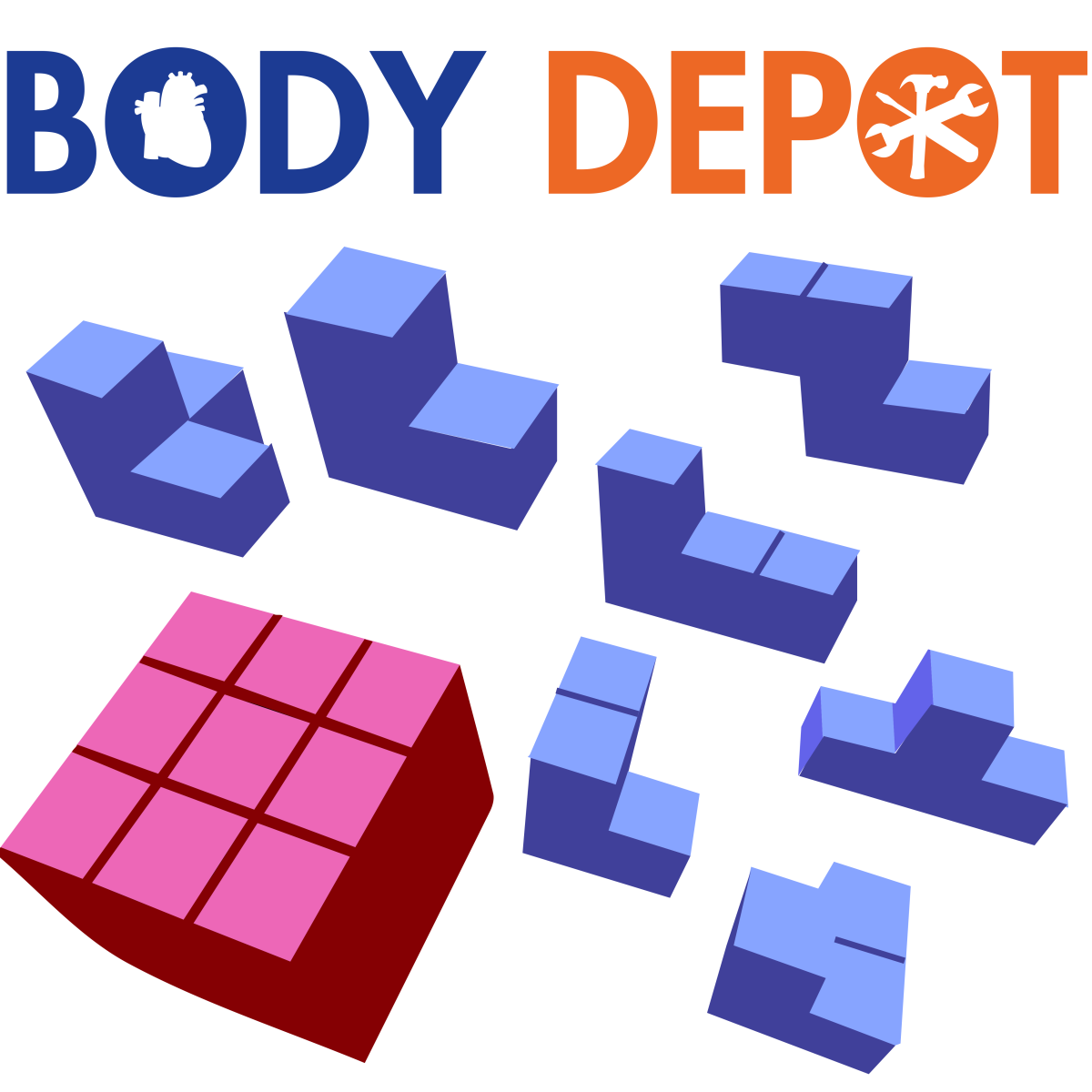
Be Part of
Ask A Biologist
By volunteering, or simply sending us feedback on the site. Scientists, teachers, writers, illustrators, and translators are all important to the program. If you are interested in helping with the website we have a Volunteers page to get the process started.

